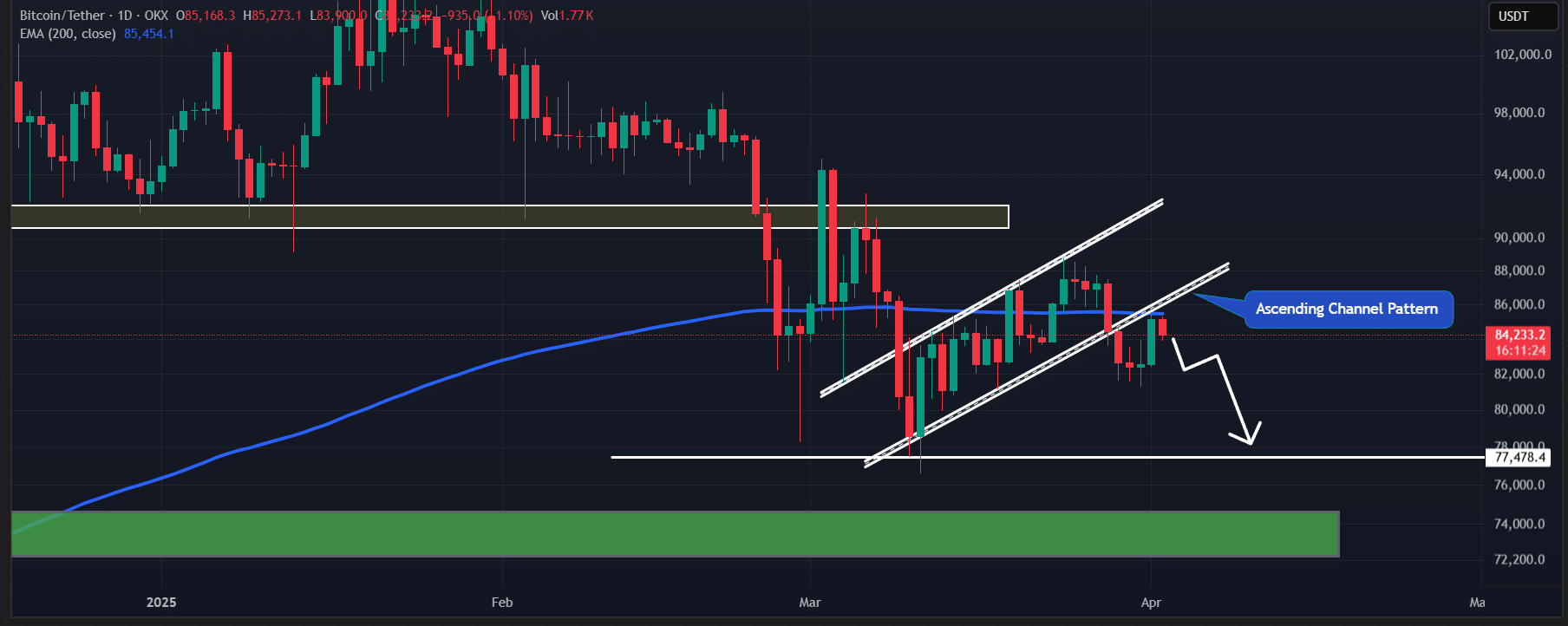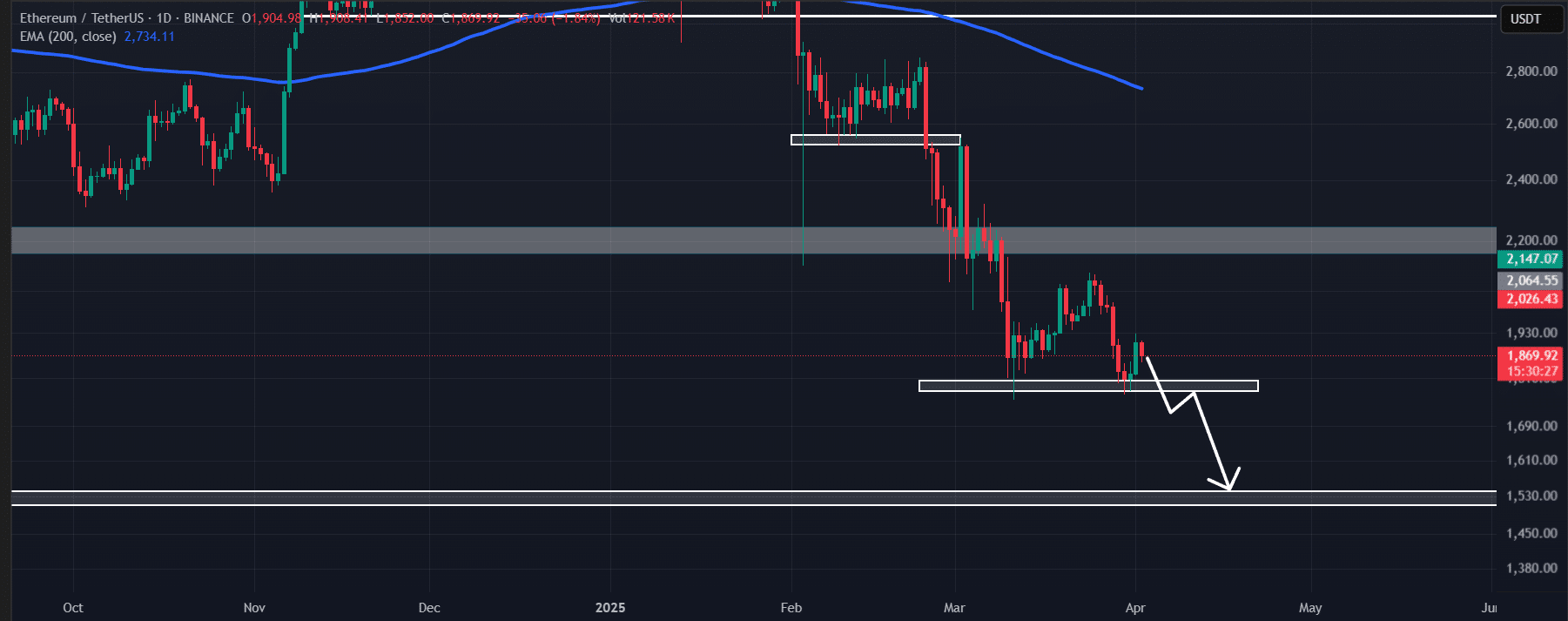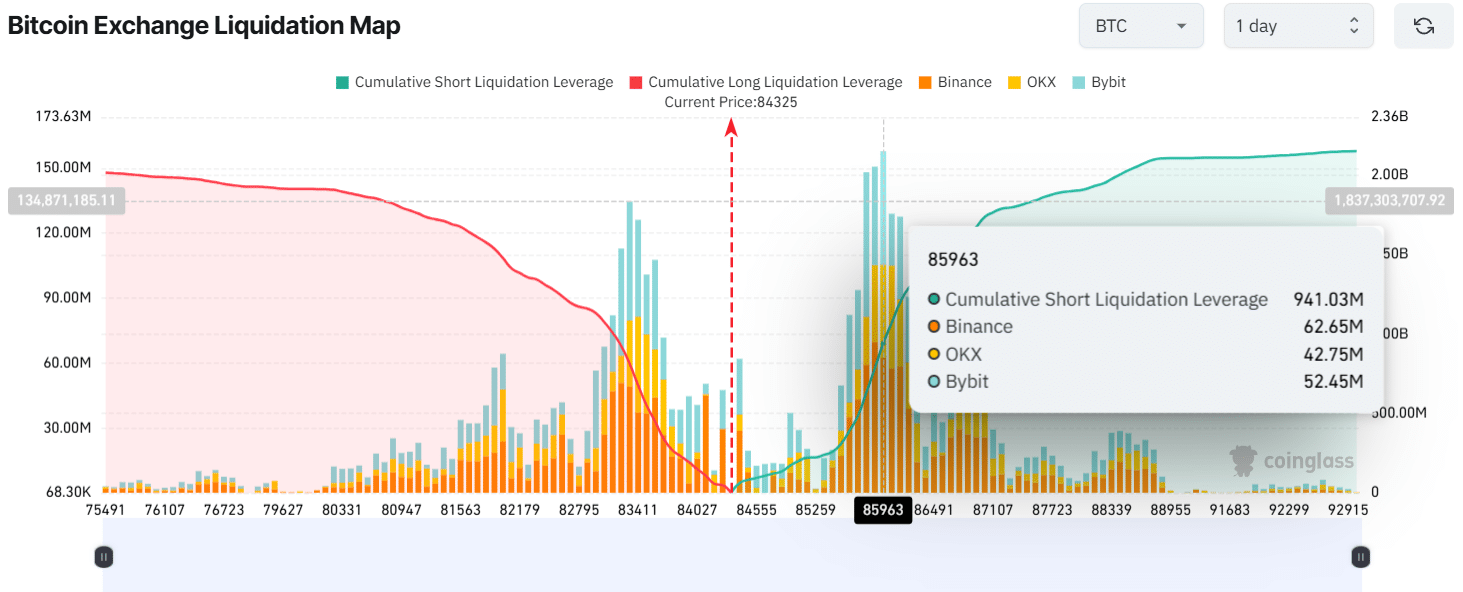| COINOTAG recommends • Exchange signup |
| 💹 Trade with pro tools |
| Fast execution, robust charts, clean risk controls. |
| 👉 Open account → |
| COINOTAG recommends • Exchange signup |
| 🚀 Smooth orders, clear control |
| Advanced order types and market depth in one view. |
| 👉 Create account → |
| COINOTAG recommends • Exchange signup |
| 📈 Clarity in volatile markets |
| Plan entries & exits, manage positions with discipline. |
| 👉 Sign up → |
| COINOTAG recommends • Exchange signup |
| ⚡ Speed, depth, reliability |
| Execute confidently when timing matters. |
| 👉 Open account → |
| COINOTAG recommends • Exchange signup |
| 🧭 A focused workflow for traders |
| Alerts, watchlists, and a repeatable process. |
| 👉 Get started → |
| COINOTAG recommends • Exchange signup |
| ✅ Data‑driven decisions |
| Focus on process—not noise. |
| 👉 Sign up → |
-
Recent tariff fears have spurred a potential sell-off of $161 million in spot Bitcoin (BTC) and Ethereum (ETH) ETFs, amplifying market volatility.
-
The ongoing tariff tensions have significantly impacted the broader cryptocurrency landscape, leading to increased investor caution and strategic withdrawals.
-
According to a recent analysis by COINOTAG, investor sentiment has drastically shifted, with many pulling funds amidst concerns over future tariff implications.
This article delves into the impact of tariff fears on Bitcoin and Ethereum, analyzing market trends and trader sentiment amidst heightened volatility.
Understanding Tariff Fears’ Impact on Crypto Markets
The cryptocurrency market is facing intense scrutiny as tariff fears loom large, leading to pronounced sell-offs and reshuffling of investment strategies. Since the onset of recent tariff discussions, the overall cryptocurrency market has experienced bearish pressure, compelling investors to reassess their positions. Notably, on April 2nd, data revealed a significant outflow of $157.8 million from Bitcoin ETFs and $3.6 million from Ethereum ETFs, suggesting a widespread liquidity crunch fueled by uncertainty.
Market Response to Tariff Announcements
As investors brace for potential tariff adjustments, many are adopting a defensive stance. Analysts indicate that large outflows from crypto ETFs can trigger selling pressure, exacerbating downward price movements. This behavior aligns with historical patterns where geopolitical tensions led to rapid asset liquidations. Noteworthy is the observation that many institutional investors have preemptively minimized exposure to high-risk assets in anticipation of the forthcoming policy announcements.
Current Price Dynamics of Bitcoin and Ethereum
Despite the prevailing uncertainties, Bitcoin and Ethereum have shown some resilience, with recent trading figures indicating a modest gain of 1% and 0.35%, respectively, over the past 24 hours. Currently, Bitcoin is positioned near $84,300 and Ethereum around $1,860. Nevertheless, market indicators suggest a potential reversal, with BTC facing significant resistance at the 200-day Exponential Moving Average (EMA), a critical technical benchmark.
| COINOTAG recommends • Professional traders group |
| 💎 Join a professional trading community |
| Work with senior traders, research‑backed setups, and risk‑first frameworks. |
| 👉 Join the group → |
| COINOTAG recommends • Professional traders group |
| 📊 Transparent performance, real process |
| Spot strategies with documented months of triple‑digit runs during strong trends; futures plans use defined R:R and sizing. |
| 👉 Get access → |
| COINOTAG recommends • Professional traders group |
| 🧭 Research → Plan → Execute |
| Daily levels, watchlists, and post‑trade reviews to build consistency. |
| 👉 Join now → |
| COINOTAG recommends • Professional traders group |
| 🛡️ Risk comes first |
| Sizing methods, invalidation rules, and R‑multiples baked into every plan. |
| 👉 Start today → |
| COINOTAG recommends • Professional traders group |
| 🧠 Learn the “why” behind each trade |
| Live breakdowns, playbooks, and framework‑first education. |
| 👉 Join the group → |
| COINOTAG recommends • Professional traders group |
| 🚀 Insider • APEX • INNER CIRCLE |
| Choose the depth you need—tools, coaching, and member rooms. |
| 👉 Explore tiers → |
Should Bitcoin remain under the 200-day EMA, analysts project a possible decline of 6.5%, potentially dragging prices down to support levels near $77,400. This scenario underscores the importance of the 200-day EMA as a decisive factor for Bitcoin’s near-term outlook.

| COINOTAG recommends • Exchange signup |
| 📈 Clear interface, precise orders |
| Sharp entries & exits with actionable alerts. |
| 👉 Create free account → |
| COINOTAG recommends • Exchange signup |
| 🧠 Smarter tools. Better decisions. |
| Depth analytics and risk features in one view. |
| 👉 Sign up → |
| COINOTAG recommends • Exchange signup |
| 🎯 Take control of entries & exits |
| Set alerts, define stops, execute consistently. |
| 👉 Open account → |
| COINOTAG recommends • Exchange signup |
| 🛠️ From idea to execution |
| Turn setups into plans with practical order types. |
| 👉 Join now → |
| COINOTAG recommends • Exchange signup |
| 📋 Trade your plan |
| Watchlists and routing that support focus. |
| 👉 Get started → |
| COINOTAG recommends • Exchange signup |
| 📊 Precision without the noise |
| Data‑first workflows for active traders. |
| 👉 Sign up → |
Source: TradingView
Ethereum’s Key Price Levels and Analysis
Ethereum’s price dynamics are equally critical, with important resistance developing at $1,780. Analysts warn that if ETH breaches this significant level, a steep decline of 15% could be imminent, with potential targets as low as $1,550. This key level serves as a pivotal point affecting market sentiment and trader strategies alike.
| COINOTAG recommends • Traders club |
| ⚡ Futures with discipline |
| Defined R:R, pre‑set invalidation, execution checklists. |
| 👉 Join the club → |
| COINOTAG recommends • Traders club |
| 🎯 Spot strategies that compound |
| Momentum & accumulation frameworks managed with clear risk. |
| 👉 Get access → |
| COINOTAG recommends • Traders club |
| 🏛️ APEX tier for serious traders |
| Deep dives, analyst Q&A, and accountability sprints. |
| 👉 Explore APEX → |
| COINOTAG recommends • Traders club |
| 📈 Real‑time market structure |
| Key levels, liquidity zones, and actionable context. |
| 👉 Join now → |
| COINOTAG recommends • Traders club |
| 🔔 Smart alerts, not noise |
| Context‑rich notifications tied to plans and risk—never hype. |
| 👉 Get access → |
| COINOTAG recommends • Traders club |
| 🤝 Peer review & coaching |
| Hands‑on feedback that sharpens execution and risk control. |
| 👉 Join the club → |

Source: TradingView
Traders’ Sentiment: A Bearish Perspective on BTC and ETH
Data from Coinglass indicates that traders are significantly over-leveraged at this juncture, with pivotal levels established at $83,320 on the downside and $85,960 up top for Bitcoin. Current positioning shows $811 million allocated to long positions against $941 million to short positions, suggesting that bearish sentiment is prevalent.
The overwhelming dominance of short positions could further depress prices, adding to the ongoing concerns around Bitcoin’s stability. Conversely, Ethereum traders also exhibit a strong bearish outlook, with over-leverage present at $1,932 and $1,840, underpinning a shift towards protective strategies as turbulent market conditions persist.
| COINOTAG recommends • Exchange signup |
| 📈 Clear control for futures |
| Sizing, stops, and scenario planning tools. |
| 👉 Open futures account → |
| COINOTAG recommends • Exchange signup |
| 🧩 Structure your futures trades |
| Define entries & exits with advanced orders. |
| 👉 Sign up → |
| COINOTAG recommends • Exchange signup |
| 🛡️ Control volatility |
| Automate alerts and manage positions with discipline. |
| 👉 Get started → |
| COINOTAG recommends • Exchange signup |
| ⚙️ Execution you can rely on |
| Fast routing and meaningful depth insights. |
| 👉 Create account → |
| COINOTAG recommends • Exchange signup |
| 📒 Plan. Execute. Review. |
| Frameworks for consistent decision‑making. |
| 👉 Join now → |
| COINOTAG recommends • Exchange signup |
| 🧩 Choose clarity over complexity |
| Actionable, pro‑grade tools—no fluff. |
| 👉 Open account → |

Source: Coinglass
| COINOTAG recommends • Members‑only research |
| 📌 Curated setups, clearly explained |
| Entry, invalidation, targets, and R:R defined before execution. |
| 👉 Get access → |
| COINOTAG recommends • Members‑only research |
| 🧠 Data‑led decision making |
| Technical + flow + context synthesized into actionable plans. |
| 👉 Join now → |
| COINOTAG recommends • Members‑only research |
| 🧱 Consistency over hype |
| Repeatable rules, realistic expectations, and a calmer mindset. |
| 👉 Get access → |
| COINOTAG recommends • Members‑only research |
| 🕒 Patience is an edge |
| Wait for confirmation and manage risk with checklists. |
| 👉 Join now → |
| COINOTAG recommends • Members‑only research |
| 💼 Professional mentorship |
| Guidance from seasoned traders and structured feedback loops. |
| 👉 Get access → |
| COINOTAG recommends • Members‑only research |
| 🧮 Track • Review • Improve |
| Documented PnL tracking and post‑mortems to accelerate learning. |
| 👉 Join now → |
Overall, the prevailing sentiment across cryptocurrency markets emphasizes caution and vigilance, particularly as ongoing tariff discussions continue to influence investor behavior.
Conclusion
The current landscape for Bitcoin and Ethereum remains fraught with challenges tied to economic policies and trader sentiment shifts. Understanding these dynamics will be vital for investors navigating this turbulent period. As the crypto market reacts to further developments, maintaining a strategic approach will be essential for mitigating risks and optimizing asset management.
| COINOTAG recommends • Exchange signup |
| 🎯 Focus on process over noise |
| Plan trades, size positions, execute consistently. |
| 👉 Sign up → |
| COINOTAG recommends • Exchange signup |
| 🛠️ Simplify execution |
| Keep decisions clear with practical controls. |
| 👉 Get started → |
| COINOTAG recommends • Exchange signup |
| 📊 Make data your edge |
| Use depth and alerts to avoid guesswork. |
| 👉 Open account → |
| COINOTAG recommends • Exchange signup |
| 🧭 Be prepared, not reactive |
| Turn setups into rules before you trade. |
| 👉 Create account → |
| COINOTAG recommends • Exchange signup |
| ✍️ Plan first, then act |
| Entries, exits, and reviews that fit your routine. |
| 👉 Join now → |
| COINOTAG recommends • Exchange signup |
| 🧩 Consistency beats intensity |
| Small, repeatable steps win the long run. |
| 👉 Sign up → |
| COINOTAG recommends • Members‑only research |
| 📌 Curated setups, clearly explained |
| Entry, invalidation, targets, and R:R defined before execution. |
| 👉 Get access → |
| COINOTAG recommends • Members‑only research |
| 🧠 Data‑led decision making |
| Technical + flow + context synthesized into actionable plans. |
| 👉 Join now → |
| COINOTAG recommends • Members‑only research |
| 🧱 Consistency over hype |
| Repeatable rules, realistic expectations, and a calmer mindset. |
| 👉 Get access → |
| COINOTAG recommends • Members‑only research |
| 🕒 Patience is an edge |
| Wait for confirmation and manage risk with checklists. |
| 👉 Join now → |
| COINOTAG recommends • Members‑only research |
| 💼 Professional mentorship |
| Guidance from seasoned traders and structured feedback loops. |
| 👉 Get access → |
| COINOTAG recommends • Members‑only research |
| 🧮 Track • Review • Improve |
| Documented PnL tracking and post‑mortems to accelerate learning. |
| 👉 Join now → |










